Ever wondered about a world where we walk up to the balcony only to find drones delivering food and emergency services right at our doorsteps? or towering over highways to monitor traffic? The world welcomes yet another massive industrial development that has the ability to set a benchmark for the smooth functioning of all forms of aerial traffic in the future. The unveiling of the Skye unmanned traffic management system, rumored to be capped with the most advanced technological capabilities, is something we ought to be updated about. Here’s an interesting read about Skye UTM and its widespread applications:
All About Traffic Management Systems
So what do unmanned traffic management systems actually do? Unmanned Aerial Systems (UAS) is a concept developed to bring automated aerial traffic management (ATM)-like the system to very low-level airspace. It focuses mainly on aircraft which weigh less than 25 kg, the drones. The development of drones has been underway for a considerable time now by both government and private aviation corporations around the world, as well as new tech-based start-ups.
ATMs are based upon deploying unmanned vehicles with efficient technologies, a high level of automation, and managing the increasingly growing civil applications of aerial vehicles.
Skye UTM: A Sneak Peek Into Its Features
This novel UTM system has been developed by an Indian start-up known as Skye Air. This recent launch of the Traffic Management System is a first of its kind in India, the need for which sprang up due to the heavy utility of drones in the upcoming future. Skye UTM is basically a cloud-based ATM system that aims to integrate unmanned air traffic with manned aviation airspace. It is designed to compete with the top-class competitors of its kind, with an unmatched handling capacity of 4,000 flights per hour and 96,000 flights in a day.
Applications
It will aid drone operators with high levels of situational awareness, autonomous navigation capabilities, traffic management, and risk assessment. The real-time aviation systems are able to connect to all types of drones, from surveillance drones to aerial taxis, in their airspace and have support for an absolutely detailed pre- and post-flight reporting system. Real-time monitoring will help in keeping a check on the ongoing highway and road construction works, too, thus reducing fatal road accidents that have seen a prominent rise in recent times. With the help of 3D technologies, it would offer a three-dimensional view of the drone’s airspace. It can capture over 255 parameters of UAV movements and store all the details in its black box.
Real-time display of UAV movements will enable the mapping of automatic, verified paths for the drones and update the latest airspace status. This platform will also offer regulatory access to national and regional air traffic controllers and other necessary regulatory authorities to gain a vast range of aerial information in their databases, from pilot-specific data to movement-related figures to geospatial information. Pilots will also be required to undertake some special training to add more competency to the overall operations.
Skye UTM categorizes drone airspaces into different zones on the basis of deliveries, high-speed operations, huge passenger aircraft, etc. Using its cloud architecture and real-time communication systems, it can safely and effectively integrate into all other manned aircraft to ensure a well-coordinated space for drone movements. Till now, Skye UTM has supported more than 300 successful beyond visual line of sight (BVLOS) drone flights.
BVLOS Vs. VLOS
BVLOS is one of the most talked-about emerging technologies in the drone industry. Unlike visual line of sight (VLOS) flights, which are operated within the pilot’s visual line of sight, BVLOS flights can be driven beyond the sight line of the pilot, thus covering much farther distances. BVLOS flight services are more cost effective than conventional aircraft methods like manned helicopters and airplanes. They can collect more detailed data in fewer deployments; thus can be used even in unmanned satellites with a reduced budget capacity.
BVLOS flights can conduct complex drone operations, like facilitating drones to fly without human interference, which is why they are extensively used in unmanned systems. They find a wide range of utilities mostly in defense and security operations where humans cannot enter controversial landscapes or difficult geographical terrain. This is where BVLOS services are preferred over VLOS services.
Other Aerial Traffic Management Techniques Used Worldwide
Very few countries in the world have such advanced drone traffic management systems currently. Most of them are in the development stages. Only one or two militarily equipped countries are in the race; for instance, the Netherlands has a system known as Airbus. Also, the US has the Air Map Company that has designated such a traffic management system with splendid capabilities. So one can comprehend that the nascent market is quite competitive right now.
Conclusion
This system now, just after being commercially available, can be accessible to everyone. With drone connectivity taking center stage in the years to come, there will be exponential growth in drone start-ups, which will scale up the manufacturing industry as well. Skye UTM can help take the baton forward by presenting such a platform for the future usage of drone operations across multiple industries like healthcare, agriculture, defense, real estate, transport, etc., not just in India but worldwide.

